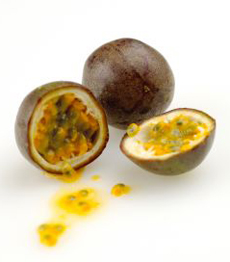TIP OF THE DAY: Passionfruit For Easter
|
|
You may have assumed, like many people, that passionfruit was named for the passion it inspires in those who consume it. But the name actually comes from a religious source, rather than any aphrodisiac properties. The fruit is named for the plant’s flower, which is said to symbolize parts of the Passion of Christ, including the crown of thorns and the nails of the crucifixion. So, add passionfruit to your Easter menu. Like pomegranate, the pulp and seeds are the edible parts of the fruit. Here are some ideas on how to use them: |
|
|
We’ve found two types of passionfruit in our market: Australia/New Zealand-grown passionfruit, which is purple and the size of a small lemon, and Hawaiian passionfruit, which is yellow and as large as a grapefruit.* The purple variety is less acidic, with a richer aroma and flavor. *Passionfruit is grown worldwide in subtropical climates, from India and Indonesia to Israel to the Caribbean and South America. And of course, Australia and New Zealand. When ripe, the flesh of both varieties is very wrinkled. Cut the fruit in half and scoop out the pulp and seeds with a spoon. According to produce expert Melissas.com, choose fragrant, shriveled, wrinkled fruit that is rich in color. If the skin is smooth, ripen at room temperature and turn occasionally. The fruit may then be refrigerated in a plastic bag for a few days or frozen for longer storage without any loss of quality.
|
||



